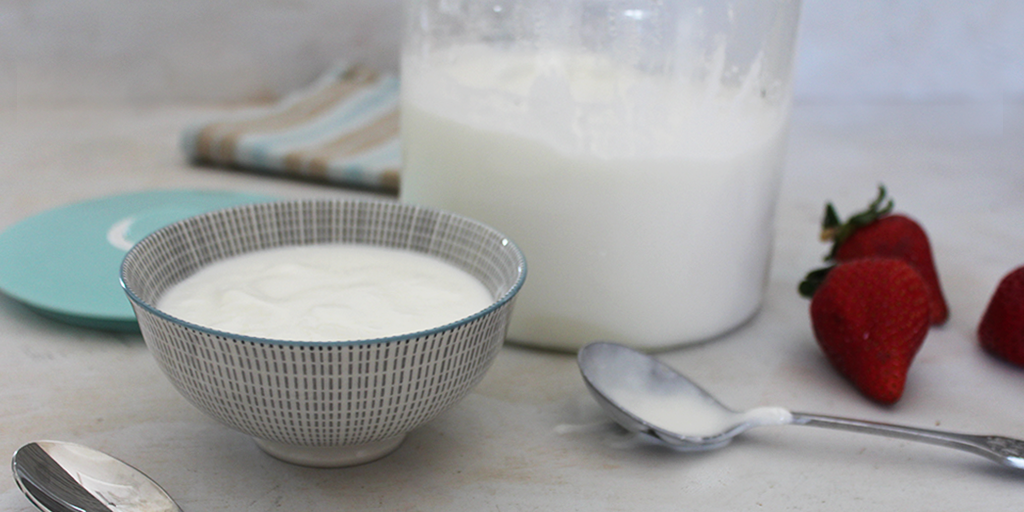24-Hour Yogurt Is The Difference Maker, Don’t Eat It At Your Own Risk!

I remember when I first read about SCD-legal 24-hour yogurt, I was immediately put off. I was new to the kitchen and cooking was hard enough without learning how to make fermented foods.
From some reading online, I figured the only reason I needed to eat the yogurt was for its probiotic effect. So, I reasoned… if I could get those probiotics in pill form, why would I ever mess around with creating my own yogurt?
Well, that’s the danger of doing incomplete research on the web. Without investigating both sides of every story, we will usually only find the side we want to hear. Of course I found the answer I was looking for – plenty of websites telling me how good it was to take some probiotic pills.
What I didn’t do was fully read about the difference between the two. Because I chose the easy way out, I didn’t start yogurt until sometime in the 2nd month of the SCD diet. This was a huge mistake, because as soon as I started it I saw a HUGE improvement in my bowel movement quality.
To understand why yogurt is different (and usually, better) than probiotic pills, keep reading.
What is Yogurt?
Yogurt is an ancient fermented food that has been eaten by people all over the world for thousands of years. But it’s not just curdled milk.
Yogurt is created when specific bacteria is allowed to ferment milk. When the bacteria ferments the milk, it becomes thicker, tangier, and more acidic – and it can keep much longer than regular milk can. It also becomes full of healthy-gut-promoting good bacteria (aka probiotics).
Traditionally, yogurt has been made with animal milks – everything from cow to goat to camel – but it can also be made with dairy-free “milks” like almond and coconut.
And because the bacteria consume the sugar in the milk (lactose) during the fermentation process, properly made 24-hour yogurt can be tolerated even by people who are lactose intolerant.
Yogurt isn’t just full of probiotics – depending on what type of milk is used, it is also high in protein and a great source of calcium and B vitamins (2,6 and 12).
Properly prepared 24-hour yogurt is an important part of the Specific Carbohydrate Diet, the Gut And Psychology Syndrome Diet (GAPS), and many other healthy gut diets.
Homemade vs. Store-Bought Yogurt
There is a huge difference between homemade 24-hour yogurt and store bought yogurts.
The obvious difference is in the quality of ingredients. Most store-bought yogurts have thickeners, preservatives, artificial colors and flavors, and WAY too much sugar.
But even if you can find a plain yogurt with no added ingredients other than milk and the bacteria, there’s another really important difference between store bought and homemade 24-hour yogurt – the amount of probiotics in the yogurt.
The probiotic content of yogurt depends on a few factors – most importantly the quality and quantity of the starter used (that’s the good bacteria added to the milk), the temperature at which the fermentation occurs, and the amount of time the yogurt is allowed to ferment.
Store bought yogurt is generally fermented for a short period of time at a higher temperature. And many store-bought yogurts are flash-pasteurized to make them shelf stable – which means they contain almost no live or active cultures by the time they make it to you.
Homemade 24-hour yogurt is fermented for 24 hours at 100-110°F. The low temperature and long ferment time allow the bacteria to consume all the sugar present in the milk and create billions of beneficial bacteria. A cup of 24-hour yogurt can contain 700 billion CFU’s (colony forming units) of good bacteria.
(And if you can find 24-hour yogurt at your health food store, be prepared to pay a lot!)
24-Hour Yogurt vs. Probiotic Supplements
Now we understand why 24-hour yogurt is much better than store-bought yogurt, but you might still be wondering… why yogurt at all? After all, you could just take a probiotic capsule and get all the good bacteria you need, right?
First, we have to consider the fact that our gut has 100 trillion bacteria inside it. Most probiotics contain somewhere between 1 billion CFUs and 5 billion CFUs – with some especially potent capsules containing 25-50 billion CFUs.
And probiotics aren’t cheap – high-potency capsules often cost $1 or more per capsule.
Compare that to the 700 billion CFUs in a cup of 24-hour yogurt – that means just one tablespoon of 24-hour yogurt contains about 44 billion CFUs.
Now, I’m not saying that probiotic supplements are bad or a waste of time or money – just that they aren’t comparable to SCD legal 24-hour yogurt. Probiotic pills have their place in the healing journey. They are especially useful in the beginning months of the diet. They are also useful when they supplement your diet with bacteria strains that are not in your yogurt starter.
But, if you’re not using 24-hour yogurt as a probiotic source, you’re really missing out on an affordable source of extremely high-quality probiotics.
How To Make Your Own 24-Hour Yogurt
So, now that you are ready to dive into the world of making homemade yogurt, where do you go to learn how?
Here are our directions for making 24-hour yogurt at home.
This is the yogurt maker we recommend using. (It is the only yogurt maker available that makes 24-hour yogurt properly.)
The take-home point of the article? Don’t neglect eating 24-hour yogurt! It is an extremely nourishing food that delivers a payload of good bacteria that are just waiting to help your gut get healthy. Probiotic supplements aren’t an adequate replacement for the power of 24-hour yogurt. But don’t throw them away, as they usually contain other good bacteria strains not available in homemade yogurt.
I know deciding to start eating 24-hour yogurt gave me a huge bump in health, and I’m sure it will for you, too! Making it at home is easy and straightforward with our directions.
– Steve
P.S. Do you still think you can’t tolerate or don’t need yogurt? Leave a comment telling us why.
Did You Like this Article?
Subscribe to our newsletter to receive email notifications, some ways to find relief, and next steps.
